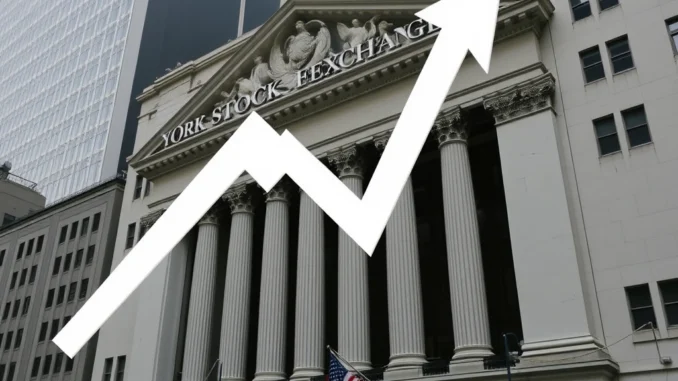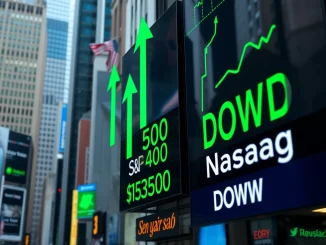
Buckle up, investors! The opening bell has rung, and it’s a sea of red on Wall Street. The U.S. stock markets have commenced trading today with a noticeable downturn, immediately impacting investor sentiment. Let’s dive into what’s causing this early morning slump and what it means for your portfolio.
Why Did the Market Open Lower Today?
The market open lower isn’t just a headline; it’s a reality that investors are facing right now. As trading began, all three major U.S. stock indexes – the S&P 500, NASDAQ, and Dow Jones Industrial Average – started the day in negative territory. Here’s a quick snapshot of the initial declines:
- S&P 500: -0.18%
- NASDAQ: -0.11%
- Dow Jones: -0.17%
While these percentages might seem modest at first glance, they represent a significant shift in market momentum right from the get-go. But what factors are contributing to this early morning stock market drop?
Several elements could be at play, influencing investor behavior and triggering this initial downturn. These could include:
- Economic Data Releases: Any overnight or early morning releases of economic data, such as inflation figures, jobs reports, or consumer spending data, can heavily influence market sentiment. Negative data often leads to immediate market corrections.
- Geopolitical Events: Global events, political instability, or international tensions can inject uncertainty into the markets, prompting investors to sell off holdings.
- Corporate News: Significant pre-market announcements from major corporations, such as earnings reports, mergers, or regulatory news, can impact not only individual stocks but also the broader market indexes.
- Investor Sentiment: Overall market sentiment, driven by a combination of the above factors and general market psychology, plays a crucial role. If investors are feeling cautious or pessimistic, it can lead to early selling pressure.
Decoding the S&P 500’s Initial Dip
The S&P 500, widely regarded as a benchmark for the overall U.S. stock market, is showing an initial decline of -0.18%. This index represents 500 of the largest publicly traded companies in the U.S., offering a broad view of market performance. A dip in the S&P 500 often signals a general cautiousness across various sectors of the economy.
Key Considerations for the S&P 500:
| Aspect | Details |
|---|---|
| Breadth of Impact | Since it includes 500 large companies across diverse sectors, a decline in the S&P 500 suggests that the negative sentiment is fairly widespread, not limited to a specific industry. |
| Investor Confidence | The S&P 500’s performance is closely watched by institutional investors and fund managers. A downward trend can influence their investment strategies and portfolio adjustments. |
| Economic Indicator | Many analysts view the S&P 500 as a leading indicator of economic health. Sustained declines can raise concerns about potential economic slowdowns or corrections. |
NASDAQ Under Pressure: Tech Sector’s Early Performance
The NASDAQ Composite, known for its heavy weighting in technology stocks, is also starting the day in the red, down by -0.11%. The tech sector has been a significant driver of market growth in recent years, making its performance crucial to overall market health. A slight downturn in NASDAQ can indicate pressure on tech valuations or concerns about future growth prospects in the technology industry.
Factors Influencing NASDAQ’s Performance:
- Interest Rate Sensitivity: Tech stocks, often considered growth stocks, can be more sensitive to interest rate changes. Expectations of rising interest rates can put downward pressure on NASDAQ.
- Earnings Expectations: The performance of major tech companies and their upcoming earnings reports heavily influence NASDAQ’s direction. Any concerns about future earnings can lead to sell-offs.
- Innovation and Competition: The tech sector is characterized by rapid innovation and intense competition. News related to technological advancements, new product launches, or competitive threats can impact investor sentiment.
Dow Jones Industrial Average: Traditional Industries in Retreat?
The Dow Jones Industrial Average, comprising 30 large, publicly owned companies considered leaders in their sectors (often more traditional industries), is showing a -0.17% decrease at the opening. While the Dow is sometimes seen as less representative of the overall market than the S&P 500, it still provides valuable insights into the performance of established, blue-chip companies. A dip here could suggest concerns in more traditional sectors of the economy or broad market unease.
What to Watch for with the Dow Jones:
- Economic Cyclicality: Many Dow Jones companies are in sectors that are sensitive to economic cycles, such as manufacturing, industrials, and consumer goods. Economic slowdown concerns can disproportionately affect these stocks.
- Dividend Yields: Dow Jones stocks are often favored for their dividend yields. Changes in interest rate environments or company-specific dividend policies can influence investor interest.
- Global Trade: Many Dow Jones companies have significant international operations. Developments in global trade and international relations can impact their stock performance.
Navigating Market Volatility: What’s Next?
The initial stock market drop serves as a reminder of the inherent volatility in financial markets. While it’s just the start of the trading day, it’s crucial for investors to stay informed and prepared. Here are a few actionable insights:
- Stay Calm and Informed: Avoid making impulsive decisions based on initial market movements. Stay updated on market news and economic developments throughout the day.
- Review Your Portfolio: Assess your portfolio’s diversification and risk exposure. Consider whether your asset allocation aligns with your long-term financial goals.
- Look for Opportunities: Market dips can sometimes present buying opportunities for long-term investors. Conduct thorough research before making any investment decisions.
- Consider Professional Advice: If you’re unsure about how to navigate market volatility, consult with a financial advisor who can provide personalized guidance.
In Conclusion: A Wary Start to the Trading Day
The U.S. stock markets have opened on a negative note, with the S&P 500, NASDAQ, and Dow Jones all experiencing early declines. While the day is still young, this initial slump underscores the dynamic and sometimes unpredictable nature of the market. Investors should remain vigilant, stay informed, and focus on their long-term investment strategies as the trading day unfolds. Keep an eye on further market updates and analysis to understand how these initial trends develop throughout the day.



